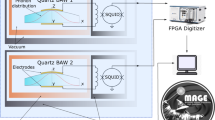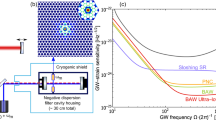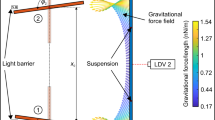Abstract
IN a series of classic articles, Weber1–3 derived the equations of motion and the response of mass quadrupole detectors to tensor gravitational waves. He has also constructed a detector which is a cylindrical rod tuned to its fundamental longitudinal acoustic resonance. These devices (class 1 detectors) have a definite relationship between the resonant frequency and the dimensions, in consequence of which they become very large (and expensive) at low frequencies. Using a somewhat arbitrary criterion (discussed later), one may state that class 1 detectors are difficult to build at frequencies below 1,000 Hz. There are other mechanically resonant devices (for example, tuning forks, rings and hollow “squares”), which we call class 2 detectors, which have a different relationship between the resonant frequency and their dimensions. Application of the same arbitrary criterion to class 2 detectors establishes that their useful frequency range can be extended to ∼30 Hz and that their sensitivity at the lower frequencies is comparable with class 1 detectors. Thus class 2 detectors are useful in a frequency range not easily accessible to class 1 detectors.
This is a preview of subscription content, access via your institution
Access options
Subscribe to this journal
Receive 51 print issues and online access
$199.00 per year
only $3.90 per issue
Buy this article
- Purchase on Springer Link
- Instant access to full article PDF
Prices may be subject to local taxes which are calculated during checkout
Similar content being viewed by others
References
Weber, J., General Relativity and Gravitational Waves (Interscience, New York, 1961).
Weber, J., Phys. Rev. Lett., 17, 1228 (1966).
Weber, J., Phys. Rev. Lett., 18, 498 (1967).
Landau, L., and Lifshitz, E., Theory of Elasticity (Pergamon, Oxford, 1959).
Author information
Authors and Affiliations
Rights and permissions
About this article
Cite this article
DOUGLASS, D., TYSON, J. New Class of Gravitational Wave Detectors. Nature 229, 34–36 (1971). https://doi.org/10.1038/229034a0
Received:
Issue Date:
DOI: https://doi.org/10.1038/229034a0
This article is cited by
-
String as a gravitational antenna
Il Nuovo Cimento B Series 11 (1992)
-
Cross-sections of a cylindrical antenna for gravitational waves
Lettere Al Nuovo Cimento Series 2 (1974)
-
Recent developments in the theory of gravitational radiation
General Relativity and Gravitation (1972)
Comments
By submitting a comment you agree to abide by our Terms and Community Guidelines. If you find something abusive or that does not comply with our terms or guidelines please flag it as inappropriate.



